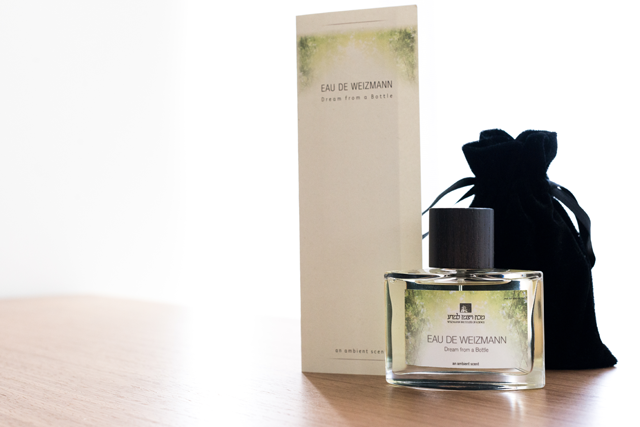
If you know art when you see it, what about when you smell it? L’eau de Weizmann: A Dream in a Bottle arrived at Science House today. When we sprayed it, the scent of a campus 5,671 miles away in Rehovot, Israel filled the air.
Spearmint, orange and a touch of rose reminiscent of Vera Weizmann’s rose garden, L’eau de Weizmann includes watery, airy notes, including one based on acetone- the “quintessential Weizmann molecule,” invented by Dr. Chaim Weizmann.
Other elements are inspired by olive leaves, woody twig extracts, melon, and the crisp, spring feeling of fresh flowers including biolet and foliage reminiscent of the campus of the Weizmann Institute, where over 2,000 scientists work across disciplines on groundbreaking science for the benefit of humanity. Check this out--you won’t believe your eyes.
How can Weizmann bottle the scent of trees and woods, inspired by fresh ambergris, sandalwood, soft cedar, soft blond woods, and a small dash of a rich resin from Asia? And the description of the scent includes something that I, a mere novice, would not have detected with the naked nostril: bat fur. Bat fur. But just a touch.
At the back of the fragrance exists a sliver of a soft, clean bat-fur-like touch to give a je-ne- sais-quoi sensation of care and elegance.
The scent was created by Christophe Laudamiel, the Master Perfumer at DreamAir Studios, a scent sculptor, "osmocurator" and chemist champion who has created scents for beauty and fashion houses such as Estee Lauder, Ralph Lauren and Abercrombie and Fitch. Artistically, Christophe co-created scents for the Garden of Addiction in Grasse and Marseille and has had four solo olfactory shows in the last three years in New York City and Berlin.
The Science of Smell at Weizmann
One hundred years ago, Alexander Graham Bell asked: “Can you measure the difference between one kind of smell and another? It is very obvious that we have very many different kinds of smells, all the way from the odor of violets and roses up to asafetida. But until you can measure their likenesses and differences you can have no science of odor.”
This lack of a scientific quantifiable measure for smell was recognized by Prof. Noam Sobel and his students in the Department of Neurobiology at the Weizmann Institute of Science as a major obstacle towards scientific understanding of how the brain enables smell. So they do what they do at Weizmann: they developed a metric which generates a number that can be applied to any molecular structure or mixture of molecules.
The Sobel team has since found that this metric predicts neural activity and olfactory perception, and it allowed answering Bell’s one hundred year-old challenge in a numerical quantifiable manner. The metric revealed that rose and violet are similar to each other, and both are dissimilar from asafetida, yet violet is closer to asafetida than rose.
Sensors were then developed to allow the team to record neural activity directly from the olfactory receptor neurons to map the process of how sniffing a rose turns into an input that gets registered, processed and turned by the brain into a behavior. They are now investigating the role of olfactory processing as a diagnostic marker for Alzheimer’s, Parkinson’s and autism spectrum disorder. Patients with severe paralysis can still sniff, so they team built a series of sniff controlled devices for paralyzed individuals to control computers and wheelchairs with their noses.
While we all know that the scent of a childhood memory triggers a remembrance of things past, we know much less about the mysterious communication in our chemical scents. Emotional tears contain chemosignals that trigger a range of reactions. The Sobel team is investigating possible uses for these agents in treating disease.
All of this brings humanity that much closer to understanding the human brain and nervous system, which governs so much of how we see, smell and perceive the world, as well as how we react to it and function within it. While A Dream in a Bottle has a very beautiful scent, it also has a beautiful sentiment--the tireless work of those who are committed to science for the benefit of humanity, whether on the Weizmann campus or supporting the effort from all over the world.


